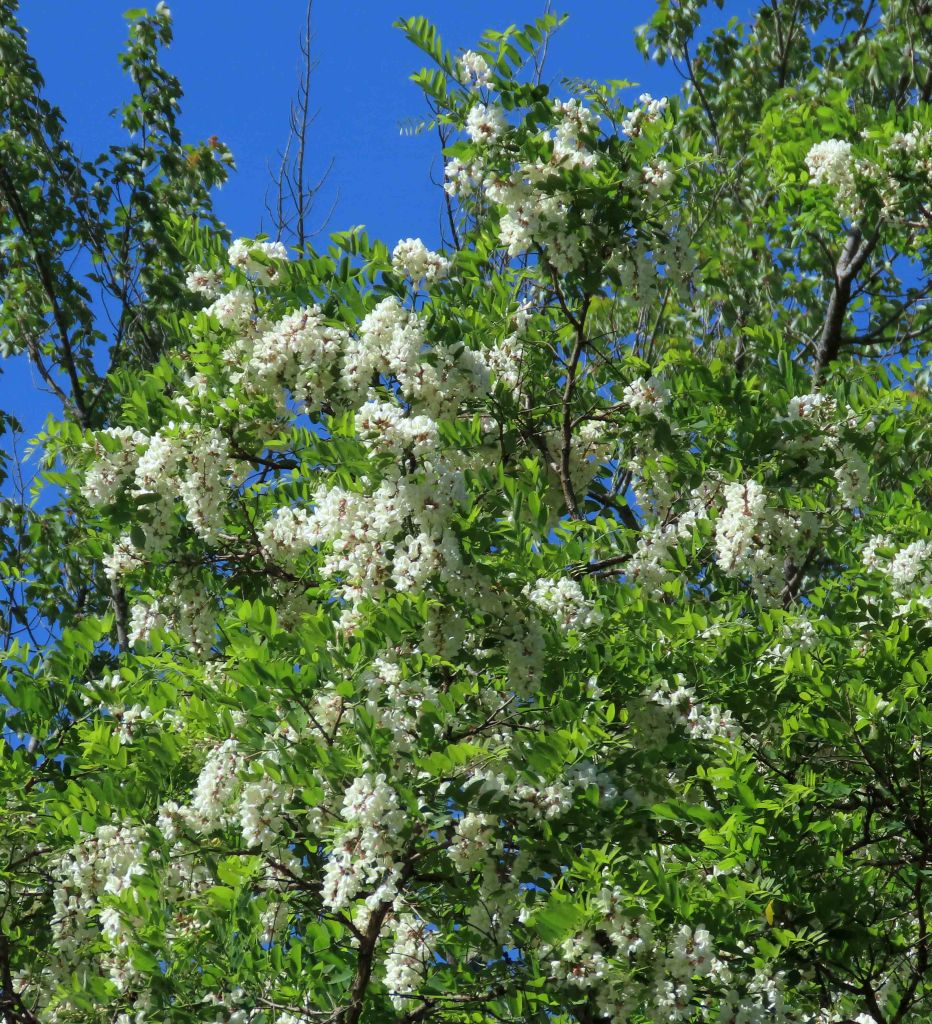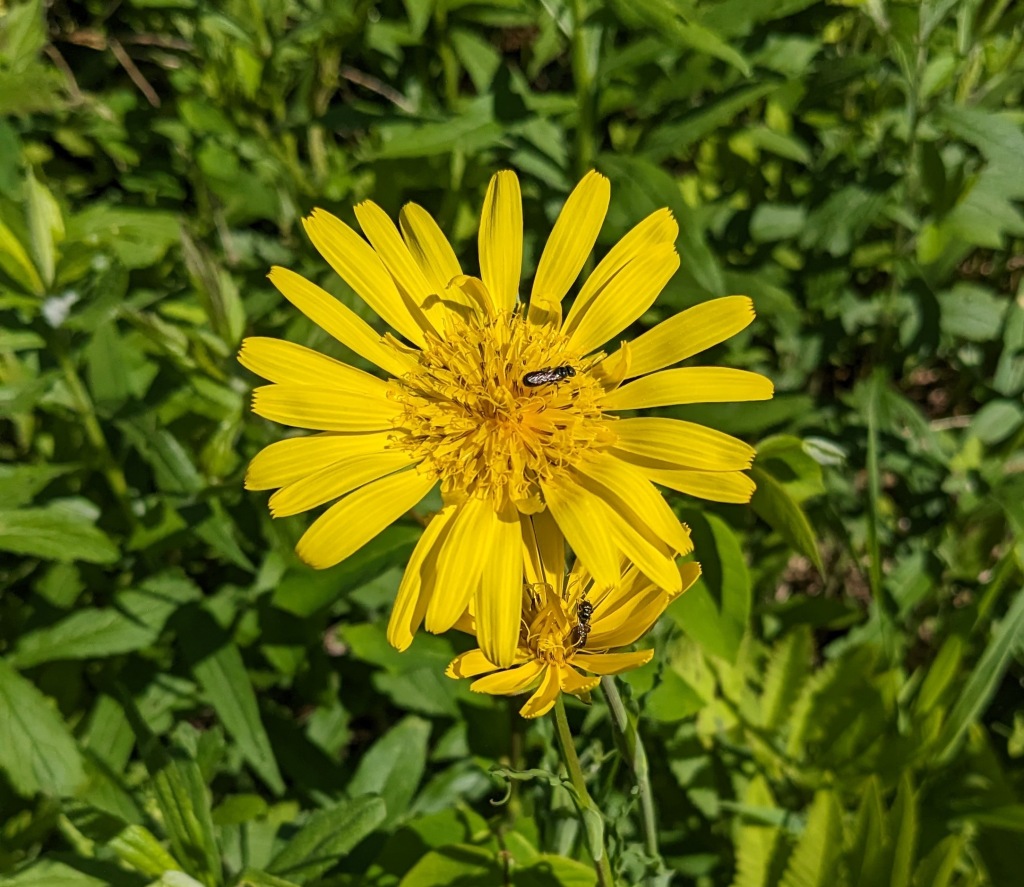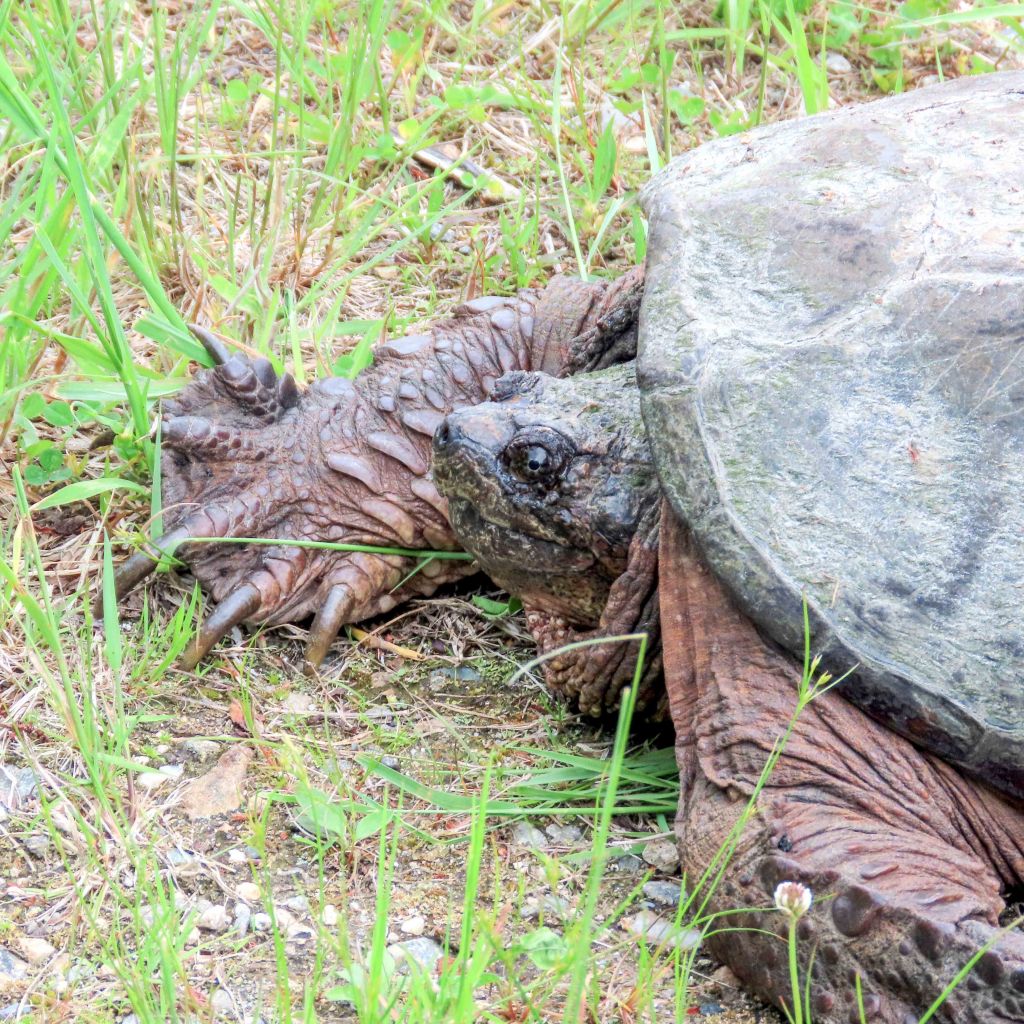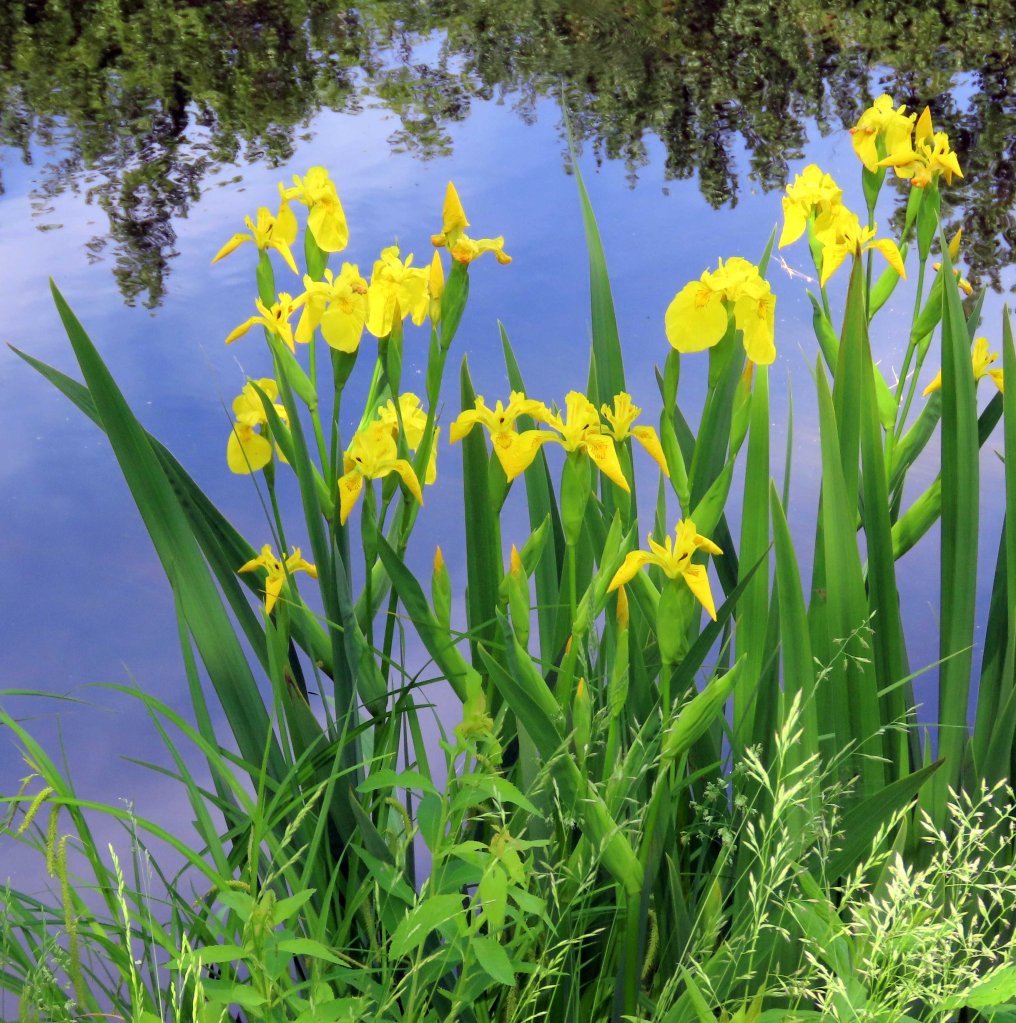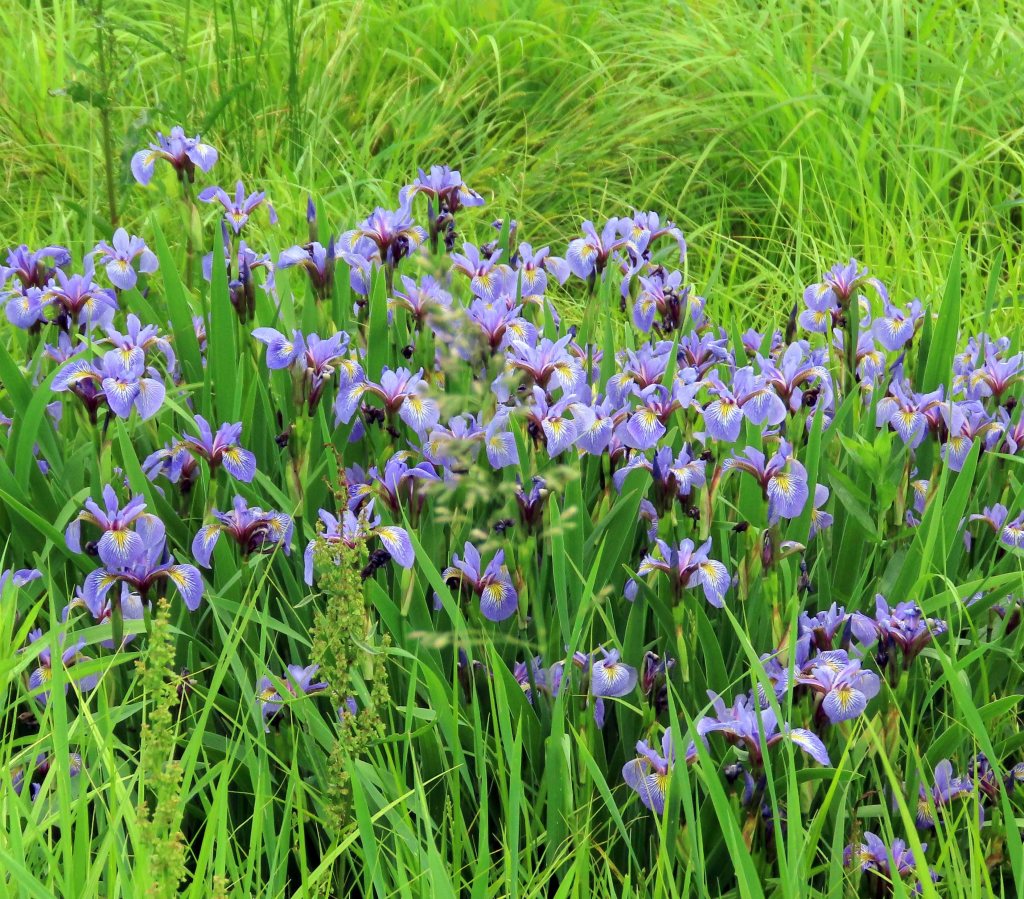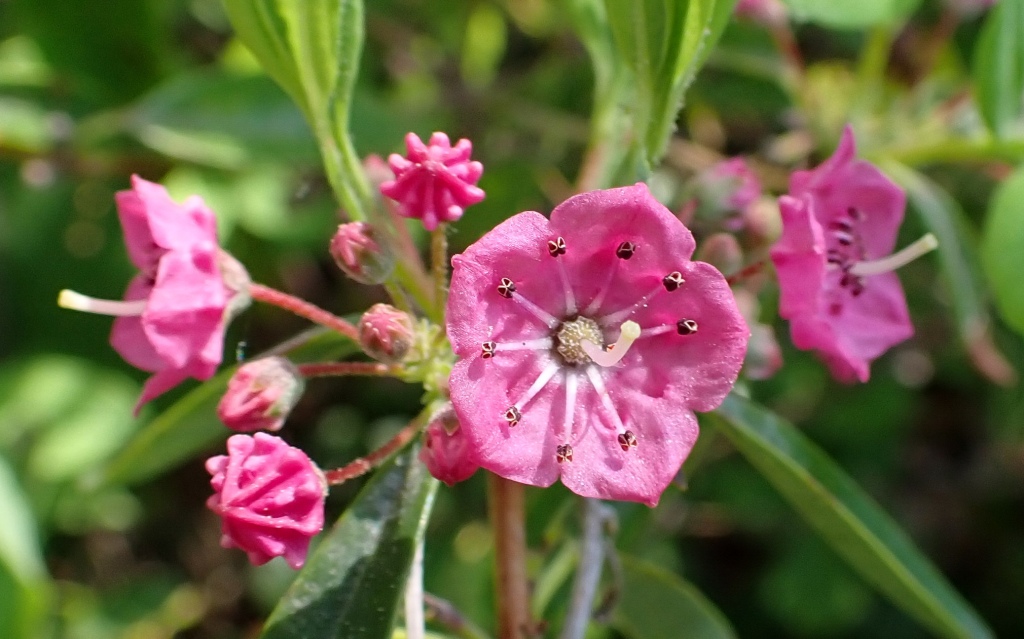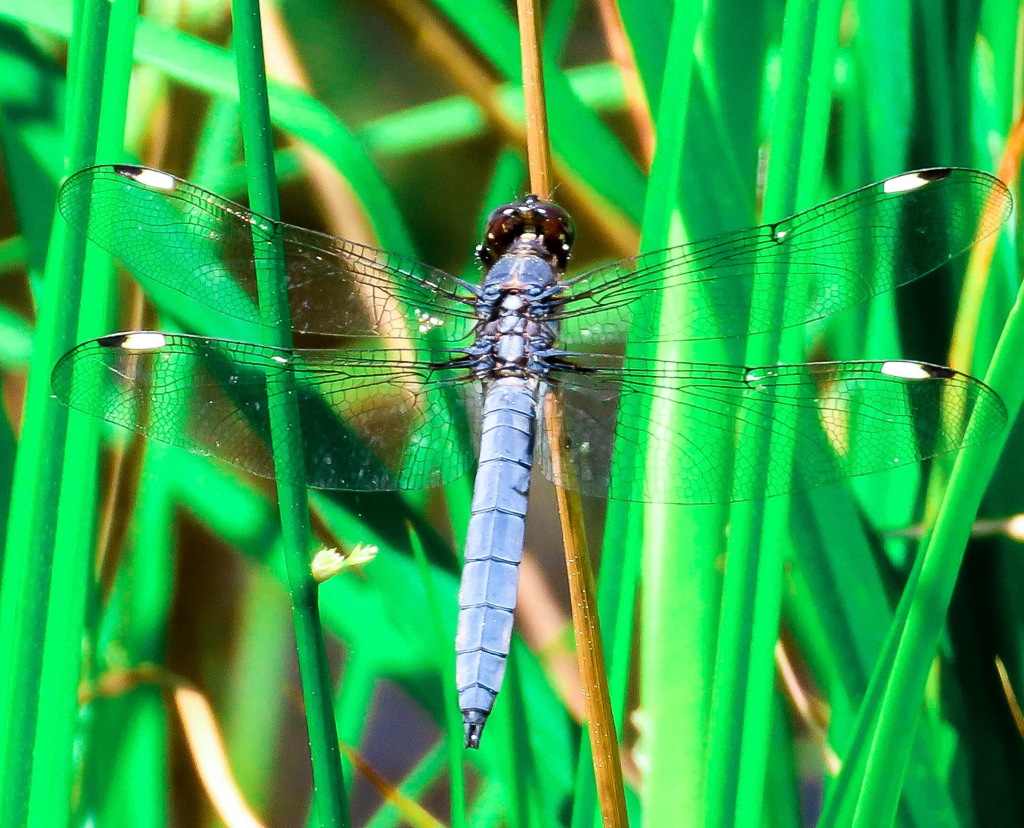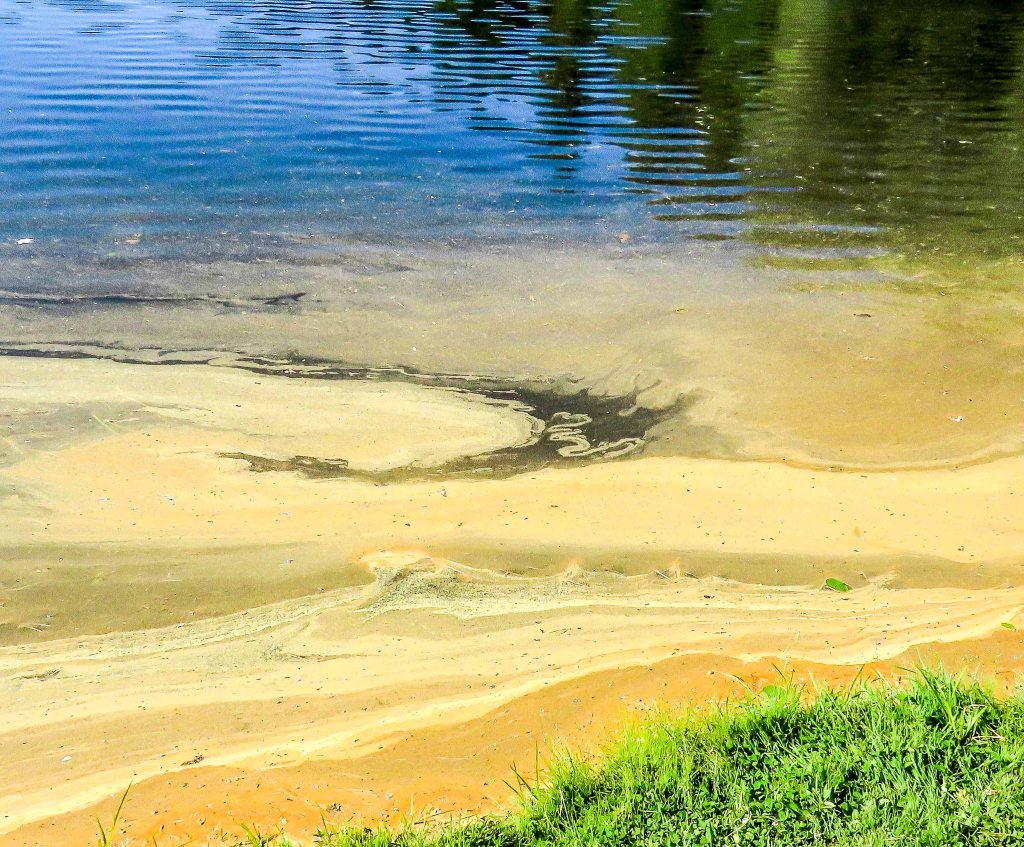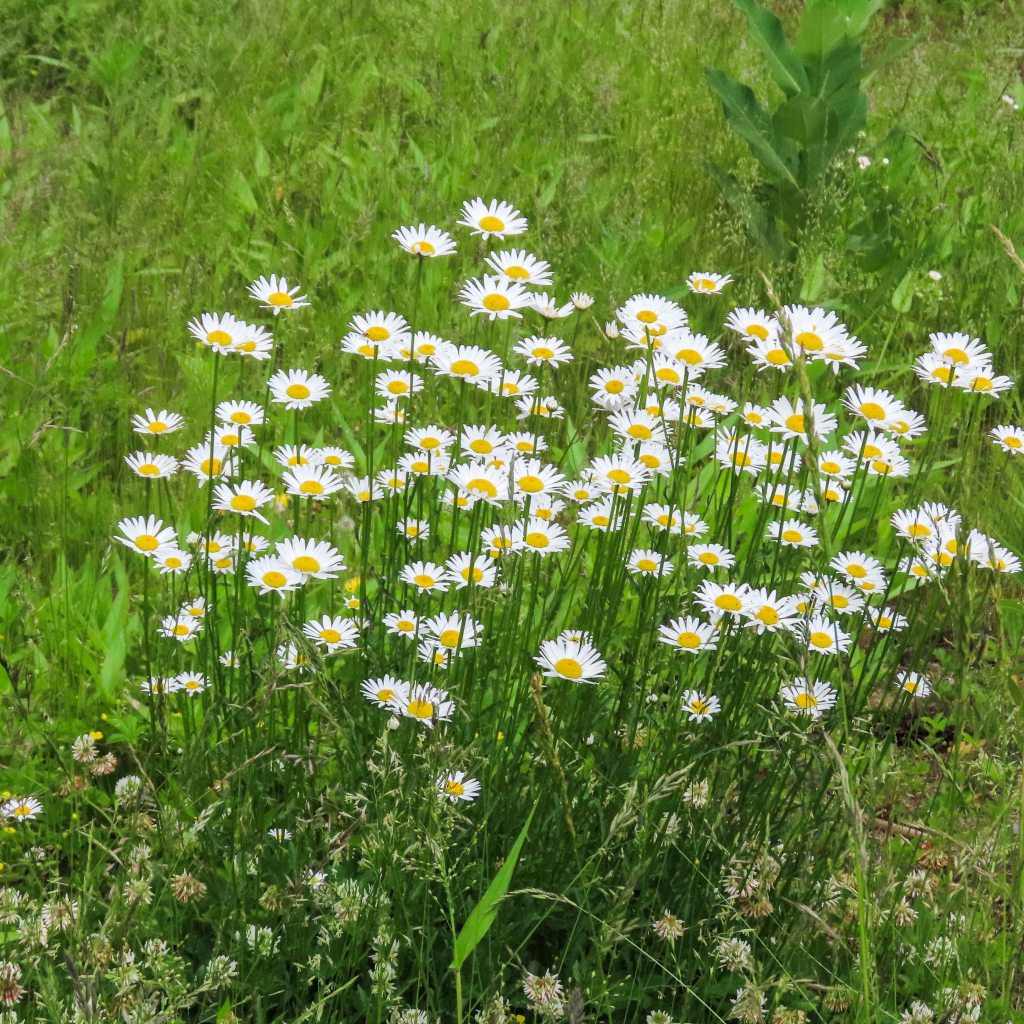
Ox-eye daisies are plants that always say June. They came over from Europe in the 1800s but they are much loved and many believe them to be native. I can say from experience that these flowers look much better in a field than they do in a vase, because they wilt quickly after picking.

I saw some type of solitary bee (I think) dancing over the petals of an ox-eye daisy. It looked like it was dressed for dancing.

Roses native to New England are the Virginia rose, the Carolina rose, the swamp rose, the smooth rose, the shining rose, and the prickly rose. We also have roses that appear to be wild but which have escaped cultivation, and I believe this might be one of those. All of them are beautiful and are much loved. I’ve never heard anyone say “Oh no, a rose!”

White admiral butterflies, which are one of our largest and most beautiful butterflies, have appeared. They’re not quite as big as a monarch butterfly but big enough to be seen from a distance. They can often be found “puddling” on gravel roads as this one was.

Though I did see one up in a tree the other day if I went back through the years on this blog I think nearly every photo I have of this butterfly would be on gravel. I can’t think of a single time I’ve gotten a shot of one on a flower. Although I’ve read that they drink nectar and sap, they also get moisture from sand and gravel.

Normally I wouldn’t show a shot with blown out highlights but since this is only the second shot of a little wood satyr butterfly that I’ve ever gotten, I hope you’ll forgive the white spots on the leaf. This is one of the “thumbnail size” butterflies and it’s very hard for me to see but I kept up with this one as it leaf hopped and tried to hide in the tall grass. Finally after about 10 minutes of following it, it sat still for more than 15 seconds and I got a shot of something I rarely see. Since the caterpillar of this butterfly eats grasses and doesn’t live off toxic plants like milkweed, the butterfly has no real protection from birds except for its erratic movements, its ability to disappear in tall grass and its eyespots, which may or may not fool a predator. All of that is why seeing one sitting on a leaf like this is a remarkable thing.

Spangled skimmers are still showing off their spangles in the sunshine. In the last post I showed this dragonfly hanging off of some vegetation with its wings spread wide but I didn’t have a side view, so here it is. This is an excellent “starter” dragonfly if you’re trying out dragonfly photography. They’re relatively common, easy to spot and easy to track from a distance due to the bright white spangles on the leading edges of the wings.

Twelve spotted skimmers are a common enough dragonfly but I’ve had quite a time finding one that would sit still this year. In fact all the dragonflies seem skittish this year, but that could just be my imagination. To get to twelve spots on this dragonfly you have to count the brown spots, not the white ones. Only mature males have these white spots; females and immature males have the twelve brown wing spots but not the white. Skimmers usually fly just above the water looking for flies, mosquitoes, beetles, and other flying insects, but the name “skimmer” comes from the way they can scoop up water to help with egg laying by using two flanges on the underside of the abdomen.
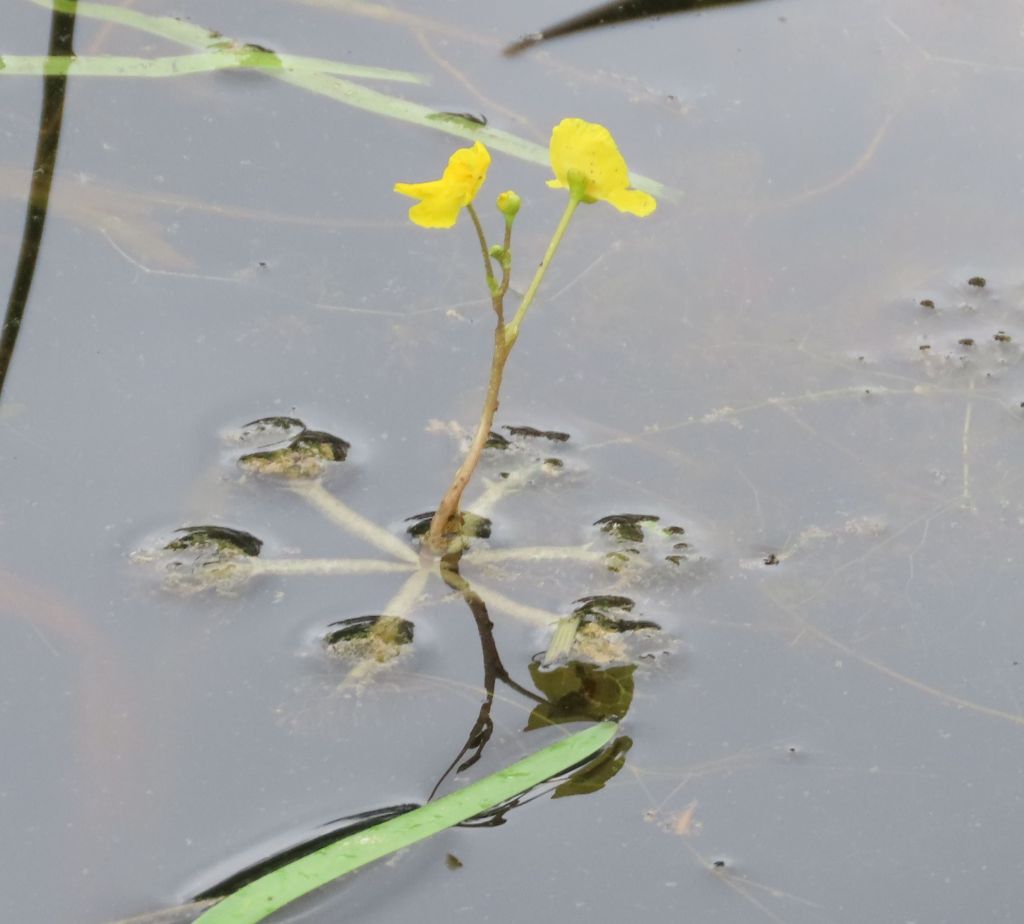
Yellow bladderwort flowers rose above its spoke shaped leaves in a local pond. The leaves of this plant have small air filled bladders on them. When an insect touches fine hairs on a bladder a trapdoor quickly opens and sucks the insect in. Once inside, enzymes digest it. Other names for bladderwort are hooded water milfoil and pop-weed. The small flowers on this one were too far offshore to get close to. In the past I’ve found them growing in wet mud along shorelines but so far not this year.

Something I’ve never seen before is a bladderwort so young the flower hadn’t even opened yet. Flower or no, this photo does show the structure of the plant like I’ve never seen it. It was so young its bladders hadn’t formed yet, but you can see some of those on the plant in the extreme lower right corner. You can also see the plant’s main stem, anchoring it to the pond bottom. I’ve pulled these plants up in the past, thinking I could get a better photo of the flowers, but as soon as they leave the water they collapse in on themselves and lose their form.

The eardrum of a bullfrog is external and is called a tympanic membrane. On females the membrane is the same size or just a bit bigger than the eye. On males it is obviously much bigger than the eye. If you’d like to compare the difference you can go back to the previous post. There was a shot of a male bullfrog in it and the difference is striking. I’d say this frog, which I’ve called Zen bullfrog due to its pose, its chosen perch, and the way it was staring off into space, is a female. I’ve read that only male bullfrogs can croak.
NOTE: As a reader has pointed out, this is a northern green frog, not a bullfrog. I was so focused on hearing, I wasn’t seeing what was right in front of me!

I didn’t want to hurt anyone’s feelings so I didn’t say anything, but I did notice that the kingbirds seem to be eating well. In fact the small pond and its surrounding area that was full of dragonflies last year has just a very few this year. The word seems to have gotten out in Birdville that the pond is a great place to dine, and now the trees are filled with chubby kingbirds.
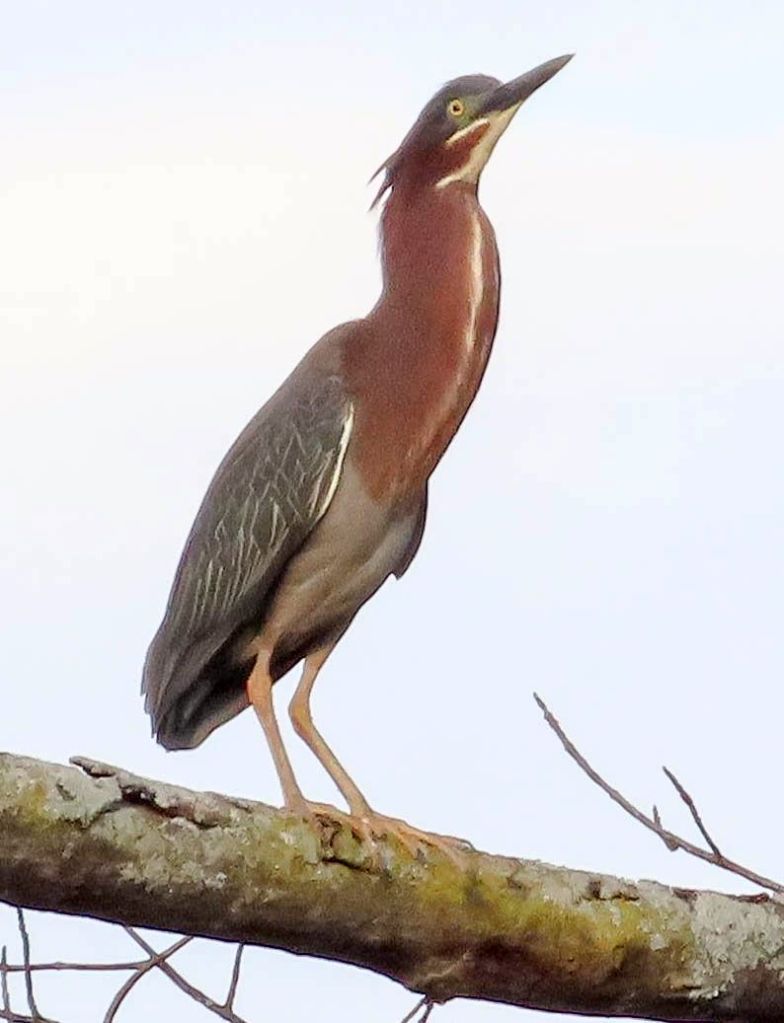
Sleek and fast is what green herons are, and they’ve just returned to some of the places I visit. I saw this one high up on a tree branch staring at the sky one evening. Soon young birds will be learning how to fish and catch frogs. They’ll put up with humans where they’re finding plenty of food but they aren’t quite as comfortable getting close to people as great blue herons are. Neither are they as big. This one looked to stand about two feet tall. They’re quite pretty birds though and are always special to see, because they aren’t something you see every day.

I always try to remember when I walk a rail trail that sometimes I’m walking through someone’s back yard, and that message was reinforced the other day when I stumbled upon a raised garden bed someone had built out of stone. The foxglove flower stalks growing wild outside the flower bed were almost as tall as I was. In old England picking foxglove was unlucky, and its blooms were forbidden inside because it was believed that they gave witches access to the house.

When I was in my late teens I worked for a nurseryman who always called these flowers peach leaved bluebells, so that’s what I’ve always called them. The thing is, I’ve never heard anyone else ever call them that, so I think “peach leaved bluebells” must just be an older name for them. In any event they’re a beautiful blue campanula and I’ve always loved them.

I find that more and more I’m drawn to the simple, uncomplicated things in life and this pretty Japanese iris fit that description perfectly. There’s nothing to ponder or think about; you can just enjoy its simple beauty.
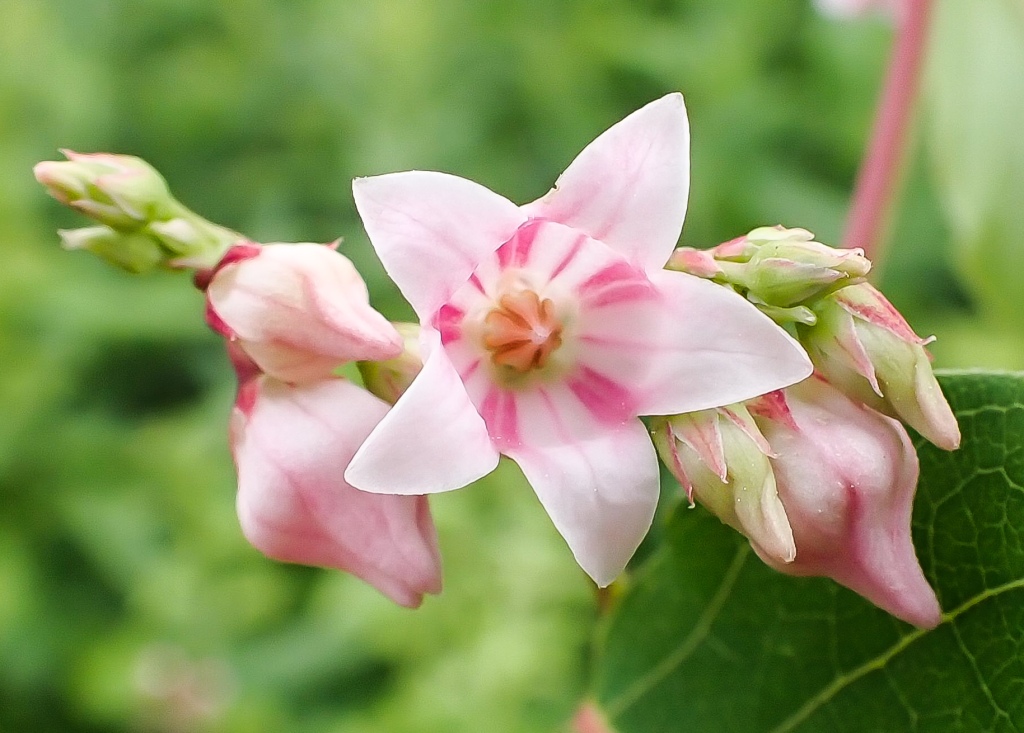
Spreading dogbane has just started blooming with its pretty (but small) candy striped pink and white flowers. It’s closely related to milkweed and attracts many of the same insects that milkweed does, especially butterflies, so if you’re looking to photograph insects it’s a good plant to spend some time with. The bell shaped flowers are just big enough to hold a pea, and very fragrant.

If you pound the stems of spreading dogbane you can tease out the strong stem fibers, and Native Americans used them as a twine for making nets for hunting rabbits, among other things. Ingesting enough of the milky latex sap can stop the heart, but using the right amount can be used to treat heart disease. It is still used in fact, in some countries.

Sulfur cinquefoil has always been one of my favorite weeds, even if it is a bit rough looking. It has a center in its buttery yellow petals that seems to shine like the sun. Sulfur cinquefoil hails from Europe, where it grows as a wildflower. Here it grows in unused pastures and along roadsides and it is considered a noxious weed in some areas because it out competes grasses. It certainly doesn’t do that here; I usually have to hunt around to find it.

Native carrion flower vines are beautiful, almost musical things when they first appear in spring. They’re climbers and their strategy is to grow so tall so quickly they can no longer support their own weight, and then they fall to one side or another. With luck they’ll fall on top of a nearby bush that they can wrap their tendrils around and climb over the top of, getting as much sunlight as they can.

Carrion flowers are small but they’re stinkers that live up to their name. In this shot you can see a green fruit forming below each flower. When ripe they’ll turn deep purple and will do their part in keeping the birds fed all winter.

Crown vetch is a very beautiful thing that is unfortunately also highly invasive. Native to Africa, Europe, and Asia it spreads quickly and chokes out native plants. Since its seed is still used by highway departments throughout the U.S. to stabilize embankments along roadways, its aggressive tendencies are either not known or are being ignored.

Multiflora rose is native to China, Japan and Korea and was imported as an ornamental. Of course it almost immediately escaped and now grows unchecked by insect or disease. I’ve seen it grow 30 feet into trees using the same strategy as the carrion flower vine we saw earlier; it sends out long shoots that eventually fall under their own weight and wherever they fall is where they grow. All that is seen here is one plant growing 15-20 feet long, more or less horizontally, supported by native shrubs like staghorn sumac. Once it grows in and over native shrubs it hogs all the sunlight and eventually kills the shrubs that support it.
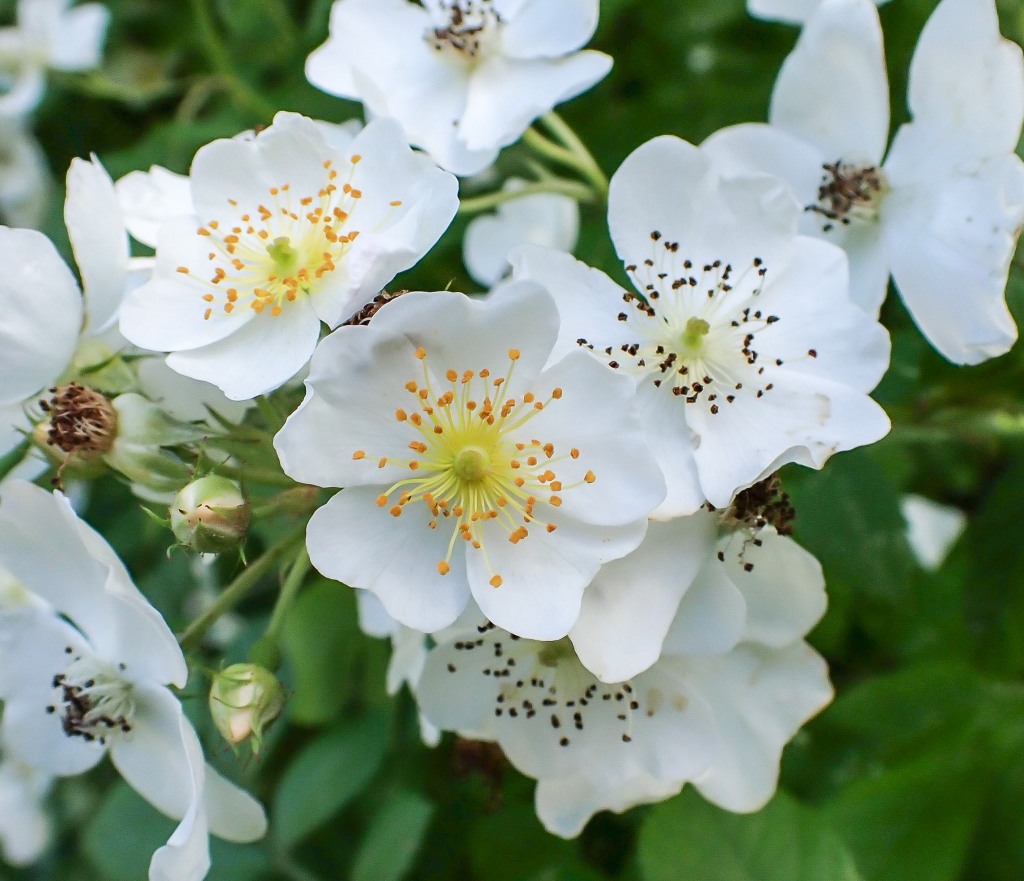
The flowers of multiflora rose are small at about an inch across, but there can be so many of them on one plant that their beautiful fragrance can be detected from quite far away. You can quite literally follow your nose right to it. The flower’s anthers start out bright yellow and become darker following pollination. Finally the flowers will become small, bright red rose hips that birds love. Its sale and distribution is banned in New Hampshire but since each plant can easily produce half a million seeds I think it’s here to stay.

Heal all has just started blooming. I call the plant nature’s cheerleader because of the way all the flowers seem to be saying Yay! In the past the plant was thought to be able to heal just about any illness a person could have, and that’s how it got its name. It is also called self-heal, woundwort, heart-of-the-earth, carpenter’s herb, brown wort, and blue curls. It is in the mint family and thought to be native to Europe, Africa, Asia and North America. In China it is used in traditional herbal medicine, so it must be native there as well.

The lowly yarrow was once so prized it was traded back and forth between nations. Once considered one of the nine “holy healing herbs” it was used to stop the flow of blood, and warring armies made sure they carried plenty of it. It has even been found in the graves of Neanderthals, so mankind has had a long relationship with it. I think of these things when I see it after it has been run over on roadsides. Once worth more than just about anything known, it is now a totally ignored weed. How times do change.

What I believe to be a calico pennant dragonfly stood on the tip of a pickerel weed leaf. It was really windy that day and it looked like it was clinging to the leaf with all its might.

It swayed this way and that like a flag, and that’s where the name “pennant” comes from. I sometimes see them hanging on with just their two front legs but on this day the wind was so strong I think it needed extra help. I’ve always had trouble getting a good shot of their wing patterns and this time was no exception. The reflective surface of the wings made a tough shot for the camera but I’m sure it made it easier for birds to see them.

At a glance blue dasher dragonflies look a lot like the spangled skimmer seen earlier in this post but they don’t have the white “spangles” on their wings; only the black stigmata. They are another dragonfly that likes to perch, and will fly off and return to its perch again and again as long as you don’t get too close.

Here is the face of a blue dasher dragonfly. What look like tall, yellow eyes are actually marks on its body. The round turquois bits with white dots on them are its compound eyes. The white dots are highlights from sunshine. I’ve read that they have a nearly 360 degree field of vision and can see 200 to 300 images per second, compared to the 60 per second we see. Almost 80% of their brain is dedicated to sight, so when you get close to a dragonfly it’s because it let you. All those times I’ve gotten close to one and thought I had snuck up on it, I was fooling myself.
To find the universal elements enough; to find the air and the water exhilarating; to be refreshed by a morning walk or an evening saunter; to be thrilled by the stars at night; to be elated over a bird’s nest or a wildflower in spring- these are some of the rewards of the simple life. ~ John Burroughs
Thanks for stopping in. Have a great, beauty filled week.

